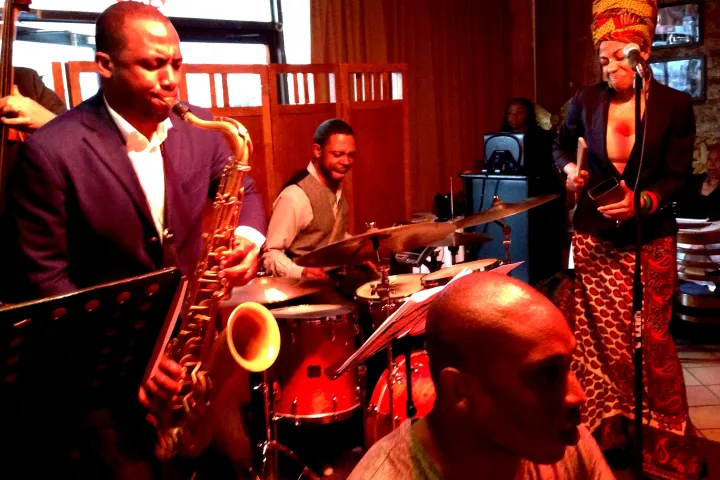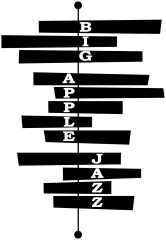New York City, NY
WSJ – The Alhambra Ballroom in Harlem
WSJ – The Alhambra Ballroom in Harlem

If you’re a hopeless romantic pining for a sepia toned, 100 year ago version of New York City you will marvel at how well-preserved Harlem still appears to be. If coming from the laughably tall and thin sky-scraper race to the clouds on 57th Street, it’s strangely comforting to note that the buildings on the south side of 125th Street between the 7th and 8th Avenues are all dwarfed by the mere 13-storied, (century old and still beautiful) Hotel Theresa. The 2008 financial meltdown and this coronavirus pandemic have unwittingly conspired to slow down 21st century development to this major Upper Manhattan corridor, allowing us wide-eyed non-market stakeholders a little more time to revel in the physical imagery of the past.
As a cultural interpreter of the musical history of Harlem and its lasting impact on the current scene – such as it is – Big Apple Jazz Tour guides ultimately benefit from all forces that slow down the inevitable changes to the landscape. In the 23 years of our existence we have witnessed the elimination of certain historic buildings and clubs that were essential parts of our tour like the Lenox Lounge, St. Nick’s Pub, 22 West, Lickety Split, La Famile, Lafayette Theater, Connie’s Inn, Small’s Paradise, The Renaissance Casino and Ballroom and the list goes on. Interestingly, we were granted a miracle in 2006 when the 1st resurrection of Minton’s Playhouse brought a welcome ebb to the inevitable flow of this depressing trend.
When news of The Alhambra Ballroom’s recent bankruptcy declaration reached the desks of the Wall Street Journal, reporter, Aisha Al-Muslim was directed to share its important place in history to mark the event. Our friends Lewis Porter and Jonah Jonathan introduced Aisha to Big Apple Jazz Tours for comment and context. Strangely, there is very little on the internet to describe the Alhambra’s importance to the ballroom scene in Harlem in the 1st third of the last century. You have to go to out of print books to find some deep information about The Alhambra Ballroom. The waters of accuracy are further muddied by the fact of an Alhambra Grill which was opened on the north side of 126th Street where Billie Holiday was noted as a singing waitress in 1934 according to the The New Grove Dictionary of Jazz. But we love doing the research.
Even though the current pandemic is wreaking havoc on tourism and business in general, we are continuing our walking tours of this beautiful area and thrilled to still be able to show off and share anecdotes of buildings like the Alhambra Ballroom daily. Private tours are encouraged for those of you looking for a safe way to tour during the pandemic. Masks are required throughout the Experience for your safety and ours. To buy tickets and see Harlem, see link below.
– Gordon Polatnick
______________________________________________
A Grand Harlem Ballroom Is Empty Again in Coronavirus Pandemic
Alhambra Ballroom, revived as an events space, is vacant after management company seeks bankruptcy liquidation
By
Nov. 11, 2020
The Alhambra Ballroom in Harlem, one of the few historic Black music venues in New York still in its original shape, sat vacant for decades, then experienced a revival as an events venue in 2003. The coronavirus pandemic put an end to the parties, leaving the ballroom’s operator in bankruptcy and the jaw-dropping space empty again.
The ballroom—added in the late 1920s to a 1905 building also known as the Alhambra—played a crucial part in the New York jazz scene of the 1930s and ’40s, hosting legends such as Billie Holiday, Duke Ellington and Bessie Smith.
Its fate highlights the rise and fall of Harlem’s grand ballrooms. Some, such as the Savoy, have been demolished. Others were transformed: The Audubon, where Malcolm X was assassinated in 1965, now serves as a memorial and education center, while the Renaissance was demolished and turned into condos.
“The days of the ballrooms sadly are over,” said Gordon Polatnick, owner of tour company Big Apple Jazz, which offers trips to jazz clubs and events in Harlem and Greenwich Village.
The Alhambra, at the corner of West 126th Street and Adam Clayton Powell Jr. Boulevard, once was a vaudeville theater with more than 1,600 seats, then a movie theater. The ballroom was added to the seven-story building’s top two floors; like many other grand spaces in Harlem, it declined and fell into disrepair in the 1960s.
WHERE JAZZ ECHOES STILL
Harlem’s historic Alhambra Ballroom, through the years.
- 1905: The Alhambra building is completed and opens as a vaudeville theater, later converted into a movie theater.
- Late 1920s: The Alhambra Ballroom opens in the building’s top two floors, eventually hosting jazz legends including Billie Holiday.
- 1960s: The ballroom falls into disrepair and remained largely vacant.2003:
- The ballroom is remodels and reopens as an events venue.
- 2006: Harlem Lanes bowling alley opens in the Alhambra building on the third and fourth floors and closes in 2012.
- 2019: Shop Fair Supermarket opens a 20,000-square-foot store on the first floor.
- 2020: Ballroom operator files for chapter 7 bankruptcy liquidation in August.

Harlem Juke Joint Tour
Your Harlem jazz tour guide customizes the best itinerary for each given night, based on the most talented players in Harlem’s most exciting jazz clubs.
185 Reviews

Harlem Juke Joint Tour
Your Harlem jazz tour guide customizes the best itinerary for each given night, based on the most talented players in Harlem’s most exciting jazz clubs.
185 Reviews

Legends of Jazz Tour
This is our premium tour! It features jazz’s international superstars, and also rising stars who deserve wider recognition.
185 Reviews

Legends of Jazz Tour
This is our premium tour! It features jazz’s international superstars, and also rising stars who deserve wider recognition.
185 Reviews

Greenwich Village Jazz Crawl
Intimate Greenwich Village Jazz Tour to discover and explore two hidden jazz haunts and the sites where Billie Holiday, Charlie Parker, and Bob Dylan made history.
185 Reviews

Greenwich Village Jazz Crawl
Intimate Greenwich Village Jazz Tour to discover and explore two hidden jazz haunts and the sites where Billie Holiday, Charlie Parker, and Bob Dylan made history.
185 Reviews

Private Tour
We’ll design your private jazz tour based on your tastes and our extensive knowledge of musicians, clubs and speakeasies throughout the city. We know what is happening nightly on and off-the-beaten-path.
185 Reviews

Private Tour
We’ll design your private jazz tour based on your tastes and our extensive knowledge of musicians, clubs and speakeasies throughout the city. We know what is happening nightly on and off-the-beaten-path.
185 Reviews

Gordon Polatnick
Gordon is the founder of Big Apple Jazz Tours. What started as a personal challenge to discover and document all of New York’s hundreds of jazz joints and to establish Harlem’s first jazz day club, has now blossomed…
Gordan Patrick Full Bio

Amanda Humes
There’s no one in New York City like Amanda! Equal parts sass, smarts, and customer service – Amanda is the Harlem resident, Columbia University graduate, and…
Amanda Humes Full Bio
